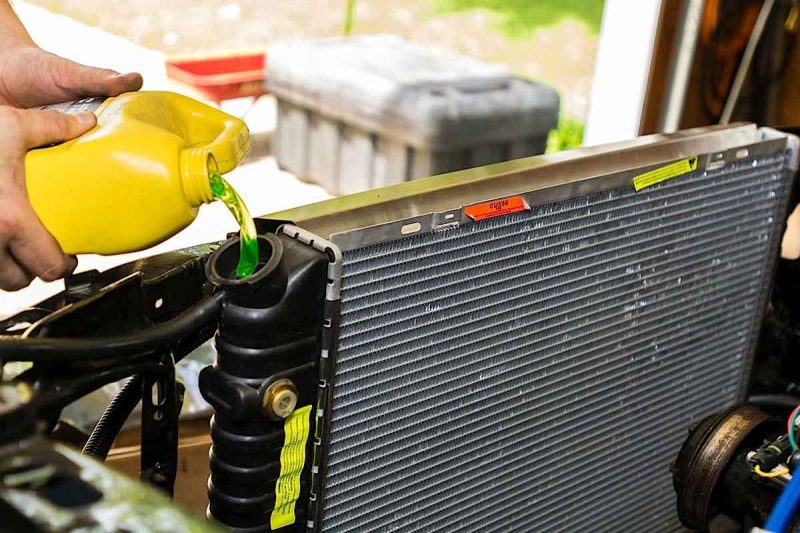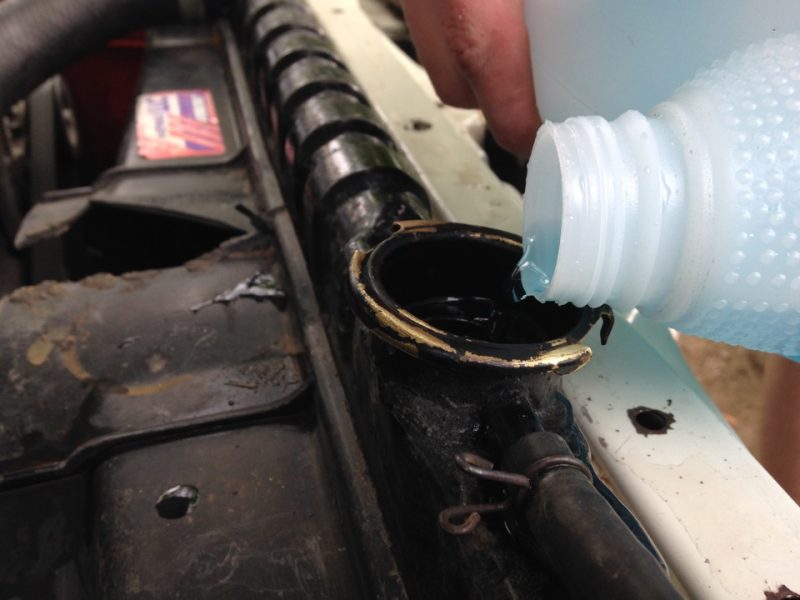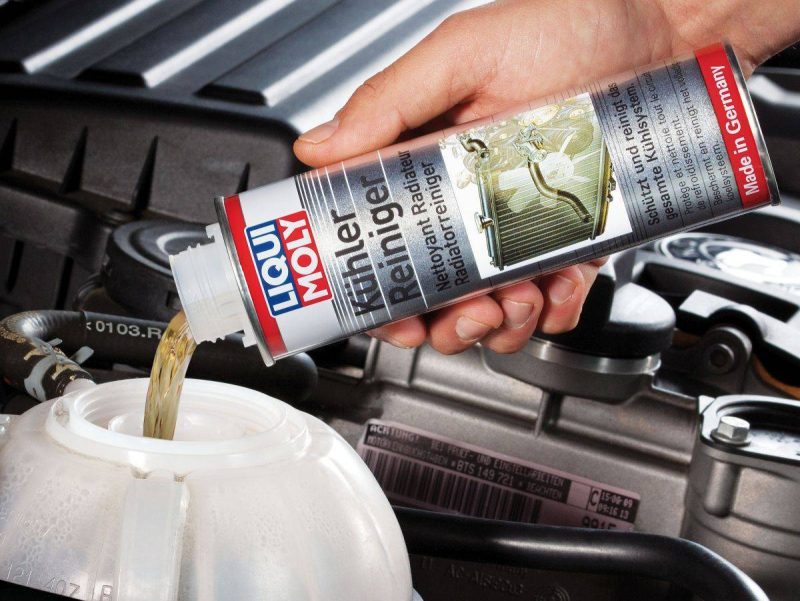When operating an internal combustion engine, about one third of the released fuel energy is spent not on useful work, but on heating the engine itself. Overheating of the engine is fraught with unpleasant, if not fatal, consequences. That is why it is necessary to have a good cooling system. And how effectively it works depends largely on its cleanliness. Therefore, flushing the engine cooling system is as important as, for example, changing the engine oil and updating filters. We tell you how to flush the engine cooling system from rust and other deposits, as well as how to do it.
Why flush the engine cooling system
Inside the cylinder block and its head is the so-called cooling jacket – a network of channels through which coolant is pumped in a closed circle. It flows through hoses and pipes to the radiator, where it is cooled and then returns to the cooling jacket.
Antifreeze, a special and rather complex liquid, is used as a coolant in modern cars. However, over time their decomposition occurs, the products of which settle inside the entire system. Also, other deposits can accumulate on the inside of the pipes, in the engine channels and in the radiator – this is caused by scale, metal corrosion, degradation of rubber hoses and gaskets.
If, when the coolant level drops, the system is topped up with ordinary tap water rather than distilled water, this will also lead to salt deposits on the surface of the channels and inside the radiator.
In general, we can distinguish two main types of contamination in the car cooling system:
- inorganic (scale, metal oxides and rust). Their presence is indicated by a whitish-brown scale on the parts of the cooling system;
- organic (mainly decomposition products of antifreeze). Their signs are primarily turbid and darkened antifreeze, as well as jelly-like deposits.
All these contaminants cause a significant reduction in the efficiency of the cooling system in the car. Which is very harmful, even if it does not bring to “boiling” of the motor. With a general increase in temperature, the system is able to cope, but local overheating is inevitable. Because of them there are problems, for example, with drying out oil caps or rapid overgrowth of pistons and their rings with carbon deposits, because of which it is necessary to perform engine deoxidation.

So even when using high-quality antifreeze, it is impossible to completely exclude the problems of contamination of the cooling system. Therefore, it is better to flush the engine cooling system and radiator than to spend much more money on engine repair.
How to know that the cooling system needs flushing
It is desirable to flush the engine cooling system during each coolant change – the terms of its scheduled renewal are specified in the car’s instruction manual. They are up to 5 years and more (including depending on the service life of the original fluid used).
However, the need to flush the cooling system may arise even earlier. For example, after buying a used car with significant mileage and unclear history of operation – it is better to be reinsured.
In addition, the reason to check the cleanliness of the cooling system and flush it may be:
- Permanent operation of the engine at an increased temperature (this will be reported by the coolant temperature gauge above the usual mark).
- Insufficient efficiency of the “heater”.
- Frequent activation or operation at higher speeds of the radiator fan.
Finally, the reason for flushing may be the state of the coolant itself. Cleaning is necessary if the liquid is darkened, oil stains or foreign particles (for example, flakes or dirt) are visible in it.
What to flush – folk and specialized means
Is it possible to flush the cooling system with ordinary water? You should not. To flush the cooling system from significant contaminants, two types of special means are used, differing in chemical composition:
Flushing liquid, the basis of which are various acids. Such compositions better cope with cleaning the cooling system from inorganic compounds.
Alkaline liquid. It is more suitable for removing organic contaminants from the cooling system.
Since both acid and alkali are available, there are many “folk” recipes for homemade liquids to wash the radiator inside and the cooling system as a whole.

For example, these are all sorts of acid solutions, which are made at home on the basis of citric acid, lactic acid, vinegar essence, orthophosphoric acid (it is contained, in particular, in drinks like Coca-Cola or Pepsi). And a popular remedy for an alkaline solution is caustic soda (sodium hydroxide).
However, even properly prepared “folk” means can be insufficiently effective and cause damage to engine parts made of aluminum, plastic or rubber. Also, with overly aggressive and concentrated flushing of the cooling system and radiator, their narrow channels may be clogged with rust or scale particles.
To clean the radiator and the entire engine cooling system, it is better to use special liquids. Manufacturers of autochemistry offer them in a wide range, cost such means quite reasonable money, and most importantly – when following the instructions for their use, they are known to be safer for all parts of the cooling system.
In addition to acid and alkaline, there is a two-component rinse for the cooling system, the elements of which are used in turn: first the cooling system is washed with the first component, then the second. Such cleaning agent is the most effective and is able to remove scale from the cooling system, but it is more expensive and requires more time for the whole procedure.
In addition, there are neutral, so-called soft flushes. They do not contain aggressive components, will be able to clean the cooling system less effectively and, as a rule, are used as a prevention of contamination.
How to flush the engine cooling system
Neutral flushes are used for cooling systems with minimal contamination and are usually just poured into the system shortly before the scheduled replacement of antifreeze.
But if you need to clean the cooling system with a significant amount of contaminants, the procedure can be carried out both at the service station and on your own: washing the cooling system of the engine with your own hands is quite simple and easy enough for most car owners. Engage in flushing the cooling system of the engine in warm weather can be on the street, and in winter it is better to do it in a heated garage.

Act as follows:
- Put the car on a flat surface.
- Wait for the coolant (antifreeze) to cool down.
- Drain the antifreeze from the cooling system. As a rule, there is a drain hole in the lower part of the radiator for this purpose. If there is no such – the liquid is drained by removing the lowest pipe of the system.
- Restore the tightness of the cooling by putting the plug or spigot back in place.
- Add cooling system flushing fluid or a mixture of cleaning compound and distilled water to the radiator.
- Start the engine and allow it to idle for 10 to 30 minutes (the exact time is usually specified in the flushing compound instructions).
- Stop the engine and wait for it to cool down again.
- Drain the cooling system again.
- Rinse the cooling system again (steps 4-7), but now just clean, and preferably distilled water.
- Fill with new antifreeze.
- Start the engine, turn on the heating in the cabin – as it warms up, check the level of liquid in the expansion tank.
- If necessary, top up the fluid when all air locks are out of the system.
- Check that the antifreeze is not leaking anywhere.
Briefly
- Organic and inorganic contaminants build up in the engine cooling system over time, reducing its efficiency.
- Cleaning the engine cooling system is necessary when replacing the antifreeze or early – in case of symptoms of engine overheating.
- Specialized means for flushing the engine cooling system is safer and more effective than “folk”.
- Cleaning the cooling system is not difficult, you can do it yourself.
